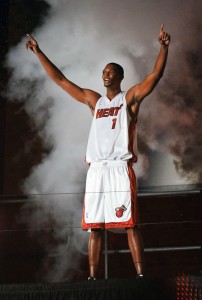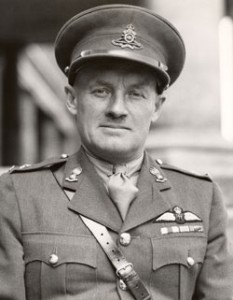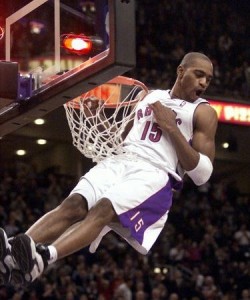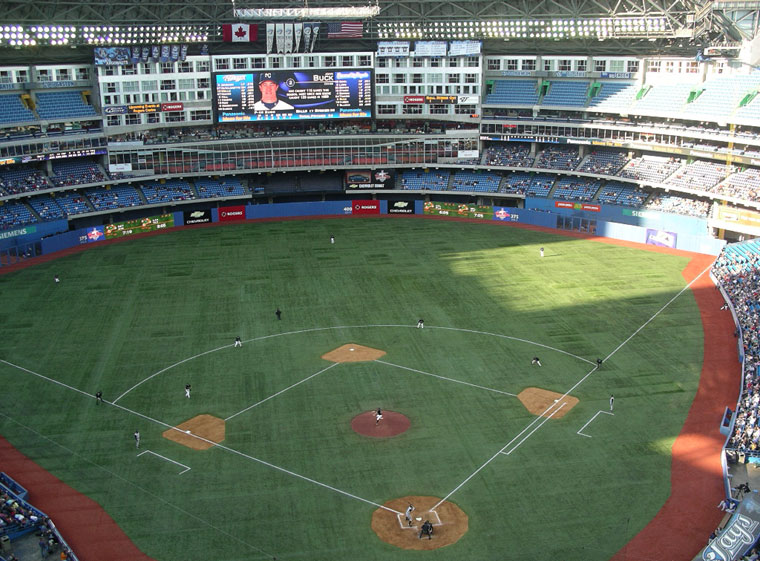Why is Chris Bosh going to be booed tonight?
Fans of the Toronto Raptors and Chris Bosh, the former star of the team, have been on a collision course since the National Basketball Association’s schedule was released two months ago.
Ever since Bosh announced he was signing with the Miami Heat, fans have been chomping at the bit to heckle and jeer him when he returns to Toronto. The wait is finally over, as Bosh’s Miami Heat will be at the Air Canada Centre tonight.
“I’m on another team,’’ he said to the Toronto Sun on Tuesday. “I would like it (to be liked) because that’s like a fairy tale ending or beginning, but that might not be the case.
“I’ll be ready for anything.”
Bosh can hope all he want, but he is going to be booed and heckled every time he steps in Toronto for the rest of his career. He will be subjected to as much vitriol as Vince Carter and Tracy McGrady are even though they’re years removed from their time on the Raptors.
Sadly, Bosh will probably never understand why he’s now the target of so much scorn in Toronto.
Ironically, the reason for the hatred is the same reason why he left: he doesn’t understand the character of the city.
He doesn’t understand that, ultimately, Toronto is a conservative place.
I don’t mean conservative in the modern, Glenn Beck, Republican sense, but the classical, small-c libertarian way, with an emphasis on individuality, entrepreneurship and, above all else, work ethic.
Founded by Governor John Graves Simcoe in 1793, the city historically stood in contrast to its Gallic cousin to the east, Montreal.
Largely inhabited by Protestants of British decent until the 1950s, Toronto’s early civic life focused on being loyal citizens to the crown, devoted members of their church and especially constructive members of the business world.
Those three characteristics earned Toronto nicknames likes “the Queen City” and “Toronto the Good”. Jokes about being able to shoot a cannon down Yonge Street on a Saturday night without hitting anyone were common. It was a staid, serious place.
Over time, monarchism and religiousness have faded and Toronto has become a more cosmopolitan, multicultural place with a vibrant nightlife. But that dedication to working hard and getting things done has remained at the core of the city.
The serious, stoic demeanour of Torontonians is often interpreted amongst other Canadians, perhaps fairly, as aloofness or even arrogance. There’s a coldness to how people carry themselves in Toronto, although defenders of the city would probably call it “walking with purpose”.
That indifference translates to the business world: It doesn’t matter who you are or where you’re from, as long as you put your nose to the grindstone and work hard, there’s a place for you in Toronto.
It’s that businesslike attitude has made Toronto the most multicultural city on Earth. It’s what makes Ontario’s capital the home of North America’s oldest continuously running Orangeman’s parade, but also allows Toronto to host one of the world’s largest LGBT Pride festivals every summer – the two seemingly contradictory events are held just weeks apart.
That spirit of efficiency and industriousness is what inspired Peter Ustinov to say “Toronto is New York run by the Swiss.”
Toronto’s workmanlike approach to, well, everything, has influenced the city’s sporting culture as well.
Like most things in Toronto’s sporting history it all starts with Conn Smythe.
The founder and long-time owner of the Maple Leafs favoured players who played a tough, relentless style of hockey. His motto of “If you can’t beat ‘em in the alley you won’t beat them on the ice” shaped the identity of the franchise, and set it apart from the free-wheeling finesse play of the rival Montreal Canadiens.
Smythe also set the tone for fan behaviour in Toronto, enforcing a strict dress code for fans at Leafs games. There’s a famous story that a wealthy couple rewarded their maid with their seasons tickets for the night. The morning after the game Smythe called the couple’s home, threatening to revoke their passes if anyone in their seats wasn’t wearing a shirt and tie or a proper Sunday dress, because the maid and her date hadn’t met Smythe’s high standards.
As a result, Torontonians have little interest in flashy athletes or raucous crowd behaviour. They want to quietly cheer on their teams and reward the players who work the hardest, not necessarily the ones with the best numbers.
Take the current roster of the Blue Jays as an example.
The most enduringly popular baseball player in Toronto this past decade is utility infielder John McDonald, despite his career .239 batting average.
I promise you that when the team’s line up is announced on opening day this spring the crowd reaction for perennial bench warmer McDonald will rival that of reigning home run king Jose Bautista.
Why? Because when McDonald does play, he puts his heart out on the field. A terrible batter, the 36-year-old veteran has won the love of Jays fans by never quitting on a play, and happily volunteering to do whatever the team needs him to do, including pitch relief or help out as the bullpen catcher.
Similarly, the Leafs have had a lengthy list of players renowned for their intensely physical style of play that has earned them the adoration of fans, even though their offensive numbers are far inferior to their contemporaries.
Players like Darcy Tucker, Tie Domi, Wendel Clark and Doug Gilmour will forever be deified in Toronto not for any goals they scored or any particularly outstanding play, but for the way they punished anyone who dared step on the ice against the Leafs.
Even when a truly gifted and talented player suits up for a Toronto franchise, it takes that same kind of hard-working, detail-oriented approach to win the fans’ devotion. Fortunately for sports fans in the city, the two best players to play in Toronto in the past 20 years are Roy Halladay and Mats Sundin, the quietest and most stoic athletes you can imagine.
This brings us to the Raptors and why poor Bosh is going to have hate, and possibly garbage, poured on him at the Air Canada Centre tonight.
It has little to do with loyalty – after all, both Halladay and Sundin left Toronto for greener pastures and they’re still beloved – and everything to do with how he left.
Whether they can articulate it or not, Torontonians are incensed by Bosh’s apparent rejection of their values.
Like Vince Carter before him, Bosh has left the Raptors to seek fame and fortune, to be flashy and find the spotlight of endorsement deals and American media attention. He left the cold, hard streets of Toronto for the glitzy nightlife of South Beach.
Worse yet, Bosh spent his last games with the Raptors sitting on the bench, nursing an injury. That is a cardinal sin to Torontonians: he was lazy.
Torontonians can understand, even appreciate, Halladay and Sundin leaving to win championships with better clubs - being rewarded for your hard work makes perfect sense to the city. But leaving for nightclubs and the easy life of sunny Florida? That is anathema.
It’s a shame, too. Bosh had showed so much promise when he was first drafted by the Raptors. Feature stories and interviews with the young rookie talked about how much work he was planning on doing in the off season. He openly discussed how he had to consume thousands of calories a day to bulk up for the more physical play of the NBA. Bosh liked to read. He was a computer science major in university.
In other words, he was perfect for Toronto.
Particularly after the disaster that was Carter’s time with the Raptors.
After all, Carter was a flashy style-over-substance player who briefly won the hearts of Raptors fans with the franchise’s deepest playoff run to date, only to blow it all by going to his university’s graduation ceremony instead of – that’s right – focussing on the task at hand and giving 100% to his team.
But slowly, the love affair between Bosh and Toronto soured. His charming videos of him working out became more self-aggrandizing and egocentric. It was less about industry and more about creating a brand.
Bosh had the negative example of Carter to try and avoid, but was also surrounded by positive role models like Matt Bonner, Jerome Williams, Morris Peterson and Jose Calderon. They’re all players who aren’t nearly as talented as Bosh, but who work hard on and off the court and were rewarded with the love and appreciation of the fans.
Instead, Bosh has opted to make a cameo on Entourage, film navel-gazing documentaries on getting his first tattoo and make over-the-top appearances with James and Dwyane Wade announcing how many championships they’re going to win with the Heat.
Bosh left because he felt like Toronto wasn't the place for him to reach the level, not just on the court, but off of it. He was right. It's no place for someone seeking fame, because they'll never find it here. The city spurns superstars.
Raptors fans, the supporters of any sports team in this city, will always favour the quiet, hard-working bench warmer over the flashy star with all the merchandise. Bosh's vision just couldn't line up with what the city demands of its sports heroes. That's not his fault, or Toronto's, it's just the way it's meant to be.
Unfortunately for Bosh, all this adds up to one thing: Toronto is going to show him no mercy. Not necessarily because he betrayed the city’s trust or because he is a bad player or because Raptors fans are particularly spiteful, but because he’s turned his back on the values the city holds most dear. Effort. Hustle. Hard work.
Chris Bosh is going to be booed tonight and for the rest of his career because he rejected the core value that governs behaviour in Toronto. He unknowingly struck at the city’s core principle, and Raptors fans will be unable to forgive him for that.
What is the best team in Toronto?
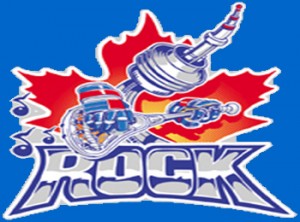 Toronto sports fans are lucky – they live in one of the few cities in North America to have a professional sports team in all four major leagues.
Toronto sports fans are lucky – they live in one of the few cities in North America to have a professional sports team in all four major leagues.
Well, okay, there isn’t really a National Football League team here, but the Buffalo Bills play two games a season at the Rogers Centre and there are the Toronto Argonauts, historically the Canadian Football League’s most successful team. Football is definitely covered in Canada's largest city.
But I digress. Toronto has eight professional sports teams, on a par with, or better than, the 14 American cities that have teams in the NFL, National Basketball Association, Major League Baseball and the National Hockey League.
Unfortunately, this creates a weird competition amongst the teams as they vie for fans attention. I was reminded of this weeks ago when a friend of mine from senior school posted on Facebook “So glad the Leafs suck more than the Raps. At least the Raps have upside”.
Of course, this was before the Raptors embarked on a Cavaliers-esque 13-game losing streak, but the comment got me wondering: what is the best team in Toronto? Which team does the best job of representing a city spoiled for choice?
Here are all of the city’s professional sports franchises, in order of winning percentage over the past two years.
| Team | This season | Last season | Cumulative |
| Rock | .667 (4-2)* | .562 (9-7)† | .615 |
| Blue Jays | .525 (85-77) | .463 (75-87) | .494 |
| Marlies | .470 (24-20-7)* | .413 (33-35-12) | .442 |
| Nationals‡ | .250 (3-9) | .583 (7-9) †¥ | .417 |
| Maple Leafs | .426 (23-26-5)* | .366 (30-38-14) | .396 |
| Raptors | .269 (14-38)* | .488 (40-42) | .379 |
| Argonauts | .500 (9-9-0) † | .167 (3-15-0) | .336 |
| Toronto FC | .300 (9-13-8) | .333 (10-11-9) | .317 |
Notes: * - Season currently underway.
† - Made the playoffs.
¥ - Won championship.
‡ - It was announced in the offseason that the Toronto Nationals have moved to the bustling metropolis of Hamilton, Ont., for 2011.
What’s most apparent in this chart is that it’s good to be a fan of lacrosse in Toronto. Especially if you live in the western part of the Greater Toronto Area, since Major League Lacrosse’s Toronto Nationals – the most recent champions in the city – are moving to nearby Hamilton.
But if you want to see a Toronto-based team do well in the regular season and go deep in to the postseason, you’d better pick up the nuances of lacrosse. The Rock are the best team in the NLL this year after losing a close game in the league championship last season.
Further, six of Toronto’s last nine championships have come from lacrosse teams, with the Rock contributing five and the Nationals bringing home the Steinfeld Cup two summers ago. The other three are all thanks to the Toronto Argonauts winning the Grey Cup in 1996, 1997 and 2004.
It’s also worth noting that attendance is seemingly unaffected by a team’s success.
Most Torontonians would immediately twig to the fact that the Maple Leafs, the city’s fifth best team, remain the most popular franchise while the Blue Jays – ranked second – had serious attendance problems last summer.
But what I find most striking is that Toronto FC, the team with the most passionate fans, has the worst record of Hogtown’s professional sports franchises.
In any event, I think this is an interesting exercise that would test perceptions of Toronto’s sports teams. Tell me: were there any surprises on this chart for you?
Stadium Review: Rogers Centre
As regular readers of this blog know, I’ve been to several ballparks in this past year. Last summer I went to Detroit’s Comerica Park, while this July I went to New York City’s New Yankee Stadium and Citifield.
However, I had never considered reviewing the Rogers Centre, the ballpark in my hometown Toronto. Not because it’s unworthy, but because I was worried that I would be too hard on a stadium that has become a scapegoat for the attendance woes of the Toronto Blue Jays as well as the Canadian Football League’s Toronto Argonauts.
But on Tuesday night I returned to the former SkyDome after a month without attending a Jays home game and I realized, hey, this isn’t so bad.
First of all, I was buoyed by the recent ESPN study that found the Rogers Centre to be one of the cleanest stadiums in all of professional sports, a small club that includes the Air Canada Centre, home of the Toronto Maple Leafs and Toronto Raptors. There are only nine other venues that have spotless health records.
Also, after my 45 minute subway ride to Citifield in Queens, New York, I have found a new appreciation for the downtown location of the Rogers Centre. It’s a five minute walk through a dedicated passage from Union Station, giving the ballpark access to the Toronto Transit Commission and the provincial GO Trains.
The neighbourhood is ideal for out-of-towners hoping to kill some time before the opening pitch. Right beside the ballpark is the CN Tower, the second tallest structure in the world. Across the street is the Steam Whistle Brewery that serves one free sample beer to any visitor over the age of 19 and also has a variety of antique train engines.
Although it lacks the charm of the newer retro-styled parks like Citifield, Comerica and New Yankee Stadium, the Rogers Centre has all the same amenities with large and conveniently placed washrooms that are easier to find than the facilities at the American stadiums.
Of course, the former SkyDome’s big draw is its roof. Although it seems like a quaint 1980s concept, the retractable dome remains practical in a city that can have snow in April. The closed dome also means that the stadium is useful all year around.
Don’t get me wrong, there Rogers Centre does have its drawbacks, especially the feeling that it is always half-empty. It can’t be helped - its seating capacity is fifth largest in Major League Baseball but Toronto averages the fourth smallest crowd in the Majors. As a result, the stadium seems deserted for most games.
As far as service goes, the staff at concessions and in the stands are fine. However, the public announcer and the rest of the in-game entertainment seem desperate to energize the staid Toronto crowd. They don’t seem to realize that Torontonians are almost always quiet at concerts, festivals and other events. It’s just in the city’s character.
Unfortunately, this year they’ve tried to boost the crowd’s excitement by cranking the music as loudly as possible, stifling conversation and drowning out any attempts at chants or cheers from the crowd. The stadium may not be quiet, but the crowd is. It distracts from the action on the field and takes away from baseball’s pastoral roots.
Toronto’s Rogers Centre is far from perfect, but it’s also not the worst ballpark I’ve ever been to. It’s accessible by public transit and is reasonably priced. It’s clean and family friendly. Unlike Fenway Park or Yankee Stadium it’s better suited to locals than visiting fans, but that’s not a serious offence for a stadium. It serves the city of Toronto admirably.
Vince Carter makes it so hard to like the Orlando Magic
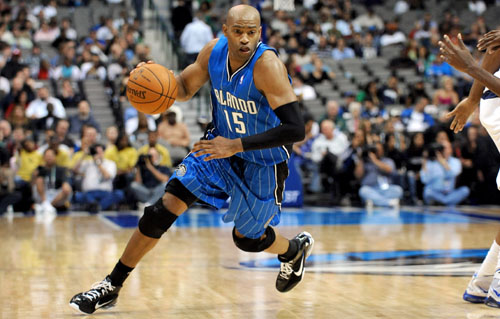 As a budding sports journalist I am supposed to shed all my personal biases. It’s one of the key sayings in the business – No cheering in the press box. You stand for the anthem, you might clap if an injured played is able to rise to their feet, but that’s it.
As a budding sports journalist I am supposed to shed all my personal biases. It’s one of the key sayings in the business – No cheering in the press box. You stand for the anthem, you might clap if an injured played is able to rise to their feet, but that’s it.
The reason behind this anti-fandom is obvious: we don’t want to betray any sort of favourite because the relationship between journalists and their audience relies heavily on the media remaining impartial. Readers need to know that our articles or reports aren’t filtered by any agendas.
That said – I’m glad I’m not covering the Orlando Magic during the National Basketball Association playoffs because I sure am conflicted about them.
Like most Torontonians, I have a deep-seeded loathing of Vince Carter. It runs deeper and longer than my career as a sports journalist, so it's difficult to shrug off.
The animosity toward Carter stems from the 2004 season – his last with the Raptors – when there was a noticeable drop in his production on the court. He was traded to the New Jersey Nets that December for what amounted to spare parts, damaging the team for the next few years.
In early January 2005, TNT's John Thompson asked Carter if he always played hard.
“In years past, no,” he replied. “I was fortunate to have the talent. You get spoiled when you're able to do a lot of things. You see that you don't have to work at it.”
As you can imagine, this flew as well as a lead balloon in Raptor-land.
Now Carter is with the Orlando Magic, one of the three best teams in the NBA’s Eastern Conference, and playing against the over-matched Atlanta Hawks.
Orlando is seemingly destined to move on to the next round of the post-season after beating the Hawks 112-98 on Thursday night to take a 2-0 series lead.
Worse yet, there is a lot to like about the Magic. They’ve got a cast of young players that have an up-tempo style of play. Their success has lead to a nice rivalry with LeBron James’ Cleveland Cavaliers, a possible opponent in the Conference Final. Most basketball fans would agree that if the Cavs and Magic meet in the playoffs, as they did last season, it'd be one of the most exciting pairings of the post-season.
In particular, centre Dwight Howard is one of the most charming players in the league. The reigning Defensive Player of the Year has thrilled at Slam Dunk competitions and always remains playful with interviewers and fans.
He’s the kind of player that you want to see succeed. But his progress will drag Carter along, putting many Torontonians, myself included, in a difficult position. We want Howard and the Magic to thrive, but is it too late for Orlando to trade away Carter?
Thank God I don’t have to report on this series. It’d be too hard to stay objective.
Toronto has two strikes against it for most professional athletes
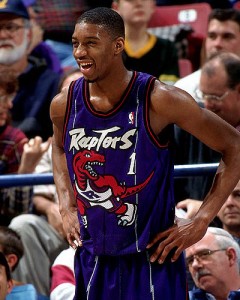
Former Toronto Raptor Tracy McGrady recently enlightened Torontonians as to why he left the Raptors.
This summer could be particularly heart-breaking for fans of the Toronto Raptors as they face the prospect of forward Chris Bosh, arguably the best player the team has ever seen, leaving the city as a free agent.
Toronto Blue Jays fans can sympathize with their basketball neighbours – this summer they lost ace Roy Halladay in a lopsided trade with the Philadelphia Phillies and Seattle Mariners.
It’s a familiar story for Torontonians. One of their teams will draft a player who becomes a star, but the franchise player eventually begins to grumble and complain about greener pastures, eventually demanding a trade or letting their contract expire and moving on via free agency.
Fortunately, NBA All-Star Tracy McGrady, a former Raptor, was in town and shed some light on the topic during a shoot-around with his teammates on the New York Knicks.
“Some guys do it for different reasons,” McGrady said. “[Bosh has] been here for quite some time now, and he's personally been successful. The team really hasn't done that much.”
And that’s the problem – teams in Toronto struggle against American competition. There are two main reasons for this:
1. The taxes in Canada limit team’s options when it comes to free agency.
Any professional athlete in a major sport (basketball, baseball, hockey) is going to earn in the high six figures.
In the United States, that would put them in the highest tax bracket, where they’d have to pay about 4.3% of their annual income to the federal government.
Employees in Canada who earn more than $126,264 pay 29% of their annual income to the federal government.
That is a jarring disparity. An athlete who earns $10 million per year on the Blue Jays or the Raptors would have to pay $2.9 million to the taxman. In the United States that same athlete would have to pay $430,000.
It’s tough to compete with other teams for prized free agents when they player will be losing 29% on the dollar just for signing on the dotted line.
2. Teams in Toronto offer less media exposure, making it a less attractive option for players.
Toronto is the biggest media centre in Canada, and actually stacks up pretty well against other North American cities in terms of population (fifth largest city, eighth largest metropolitan area).
However, sports teams based in Toronto get the short end of the stick when it comes to being televised on American networks.
Without a high profile in the United States an athlete can’t capitalize on their secondary source of income – endorsements and sponsorships. For example, Chris Bosh was drafted in 2003, the same year as LeBron James, Dwyane Wade and Carmelo Anthony. However, Bosh doesn’t even rank in the top 15 for jersey sales, and neither does Toronto for team sales. By comparison, all of Bosh’s draftmates rate highly on the list, even though they play for teams in smaller markets.
It all boils down to money. Professional athletes lose significant amounts of income from both of their main revenue sources, which makes Toronto a tough sell.
Some of you may be wondering why I haven’t mentioned hockey, a sport that has six teams in Canada? Simple, really.
Most hockey players are Canadian, and so they’re used to heavy taxation. The second largest group of players in the National Hockey League are European, who are also used to high taxes.
Beyond Sidney Crosby and Alexander Ovechkin, most players don’t expect, hockey players aren’t expecting much revenue from endorsements and sponsorship.
Also, the fact that there are six Canadian teams mitigates the lack of coverage in the United States - ESPN can ignore the Raptors and Blue Jays because they’re the only Canadian teams in the league, but when there’s at least one Canadian team playing every night and every franchise prominently features athletes from Canada, they’ve got no choice but to acknowledge non-American teams.
As an aside, all this adds to the fact that the Buffalo Bills, or any other team NFL team, would not work in Toronto.
All this is to say that in leagues where there is only one Canadian team (NBA, MLB and the MLS) there is a nearly unique set of challenges that face franchises based in Toronto. When the Raptors, Blue Jays and TFC struggle in the standings and begin to lose marquee players, it’s probably because they’re not grappling with the reality of the market.
Sure, a team can draft a young prospect, but it’s tremendously difficult to put together a team that can contend for the championship when so many players see Toronto as an undesirable city to play in.
